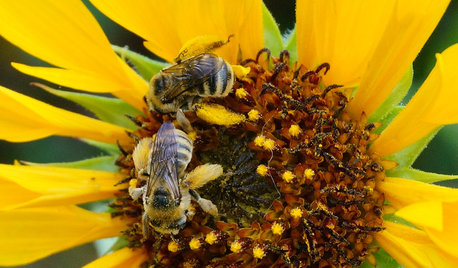The sting of Daylily losses......
charlotte428
17 years ago
Related Stories

GARDENING GUIDESNew Ways to Think About All That Mulch in the Garden
Before you go making a mountain out of a mulch hill, learn the facts about what your plants and soil really want
Full Story
GARDENING GUIDESInvite Mining Bees to Your Garden by Planting Their Favorite Plants
Look for mining bees (Andrena) pollinating woodland wildflowers in U.S. gardens this spring
Full Story
GARDENING FOR BUTTERFLIESGardening for the Bees, and Why It’s a Good Thing
When you discover how hard bees work for our food supply, you may never garden without them in mind again
Full Story
GARDENING GUIDESLessons in the Rewards of Selfless Gardening
Let go of gardening for your own vision and watch the garden’s own true vision come forth
Full Story
FARM YOUR YARDHello, Honey: Beekeeping Anywhere for Fun, Food and Good Deeds
We need pollinators, and they increasingly need us too. Here, why and how to be a bee friend
Full Story
WINTER GARDENING6 Reasons I’m Not Looking Forward to Spring
Not kicking up your heels anticipating rushes of spring color and garden catalogs? You’re not alone
Full Story
GARDENING GUIDESSmall Carpenter Bees Are Looking for a Home in Your Plant Stems
Provide flowers and nesting sites in your garden for this beautiful, tiny, metallic blue wild bee — your plants will thank you
Full Story
EARTH DAYHow to Design a Garden for Native Bees
Create a garden that not only looks beautiful but also nurtures native bees — and helps other wildlife in the process
Full Story
DISASTER PREP & RECOVERYHouzz Tour: Family Rebuilds Home and Community After Hurricane Sandy
This restored coastal New Jersey house — now raised 9 feet off the ground — offers inspiration for neighbors considering a return
Full Story
EARTH DAY12 Entertaining ‘Bee-haviors’ of Native Bees
The parade of pollinator antics is another reason to create a garden that nurtures native bees
Full Story









mmqchdygg
bambi_too
Related Professionals
Chattanooga Landscape Architects & Landscape Designers · Saint Matthews Landscape Architects & Landscape Designers · Barrington Landscape Contractors · Soddy Daisy Landscape Contractors · Tewksbury Landscape Contractors · Wallingford Landscape Contractors · Wayland Landscape Contractors · Casselberry Landscape Contractors · Alabaster General Contractors · Berkeley General Contractors · Dothan General Contractors · Janesville General Contractors · Lighthouse Point General Contractors · Melville General Contractors · Nampa General Contractorslynxe
dayliliesrus
daniel_zone_5
abbydales
simplton
simplton
simplton
MaxBaerHems
flower_lover5
lynxe
simplton
highjack
startin_from_scratch
simplton
simplton
simplton
bderm1234
lynxe
maximus7116
Ed
simplton
numama
highjack
daniel_zone_5
simplton
Edward_Kimball
laurelin
bluenosens
ladylovingdove
Maryl (Okla. Zone 7a)
beachlily z9a
thechasman
calypsogirl
Roberta_z5
amateur_expert
Roberta_z5
amateur_expert
Roberta_z5
simplton
pollinatorbob
simplton
maryslc
lynxe
fffred
simplton
Edward_Kimball
Ed
newyorkrita